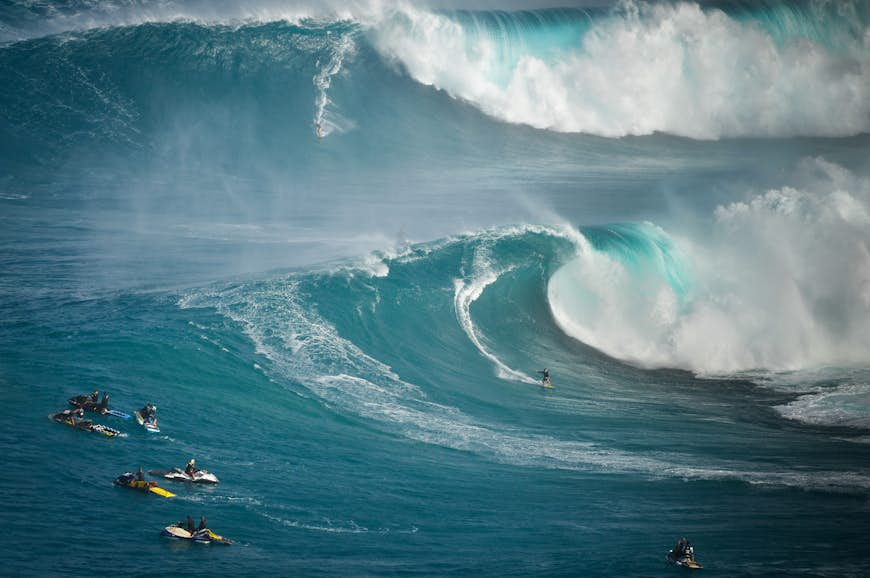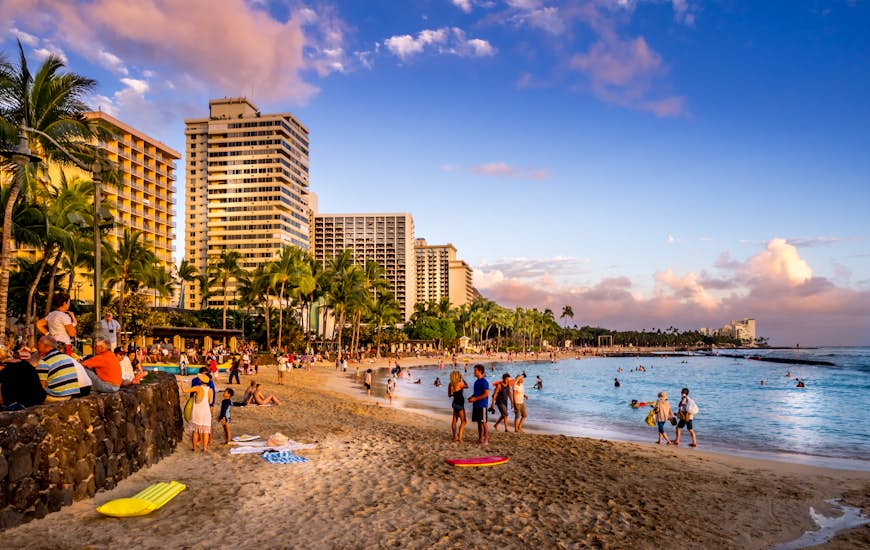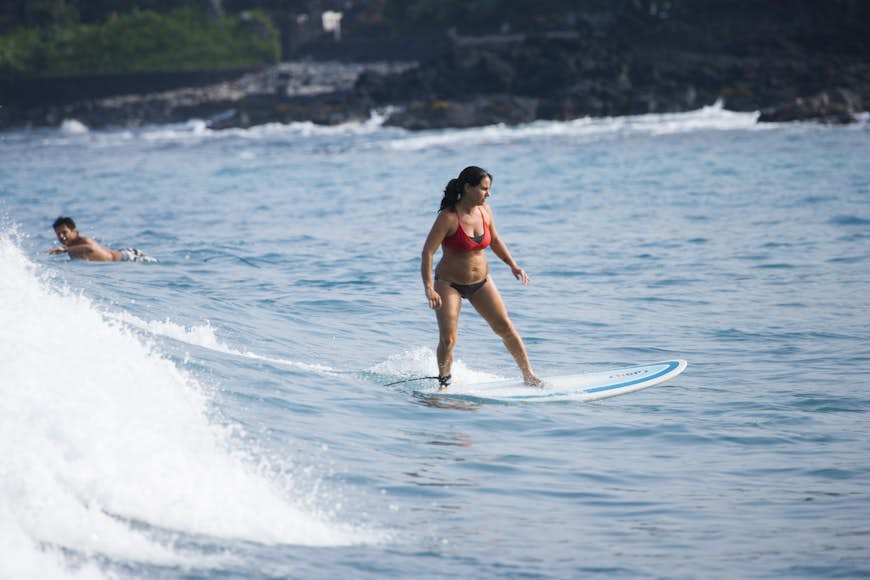Surfing walks out of the home team locker room into the glorious wave arena that is Hawaii. Whispers of daring Polynesian kings and nobles attempting to harness the ocean here go back some 800 years, back to an age when great 10-foot boards carved of Acacia koa trees were forged and high Polynesian priests appealed to the gods for swells. Yep, this is where it all began.
It should hardly come as a surprise that surf was born in the Aloha State. Swells crash through in winter from the north and roll up from the south in the summer, giving year-round conditions. You get reefs capable of holding more size than a double-decker bus next to mellow lagoons with cruisy lips of water for the beginners. It’s got something for all, no matter the season.
Surfing etiquette in Hawaii
Hawaii is pretty sacred territory in the surfing world. Everyone and their grandma want a piece, so there can be big influxes of international travelers with boards in tow, and that can put pressure on lineups.
There have been reports of rampant localism at the most-contested spots across the islands, especially on the North Shore and even in Waikiki. However, other surfers report nothing whatsoever. As a general precaution, it’s a good idea to hang on the outside of the peak if there’s a big local contingent and only go for the waves that are left. Alternatively, get up real early and try to snag the spot for yourself.
Naturally, all the usual surf rules apply in Aloha. Leave the wave for the person that’s closest to the peak, don’t try to surf waves that are already taken, and try to paddle around the break, not through it. It’s also super important that you match your skill level to your chosen spots here. Hawaii – especially its north-facing waves – are capable of bone-breaking power and rips are strong.
The best time to surf in Hawaii
Hawaii is a tale of two seasons. There’s the summer (May to August), when predominant swells come in from the south and southeast. They’re generally mellower but can get messy because of the strong easterly trade winds. The best breaks to surf during this balmy season are the ones that face south or east – think Shipwreck Beach or Waikiki.
Most pros and expert surfers will hold off for the winter season. The North Pacific rumbles into life around November, sending solid pulses of swell straight into the most legendary regions of the Aloha State. This is the time when the XXL waves of Jaws go off, when the Banzai Pipe of the North Shore begin their annual romp.

The Banzai Pipeline – Oahu
The stuff of legends
Any regular surfer worth their salt (pun intended) will know of the Banzai Pipeline. Also called, simply, Pipe, it’s the world’s most famous spot. Strong winter swells in the north and northwest channel provide the power, which is funneled through a series of perfectly positioned volcanic reefs to form a frothing wave that lips into long cylinders of water.
Paddling for this one is a leap of faith, with a drop in that’s steeper than the prices in a Waikiki hotel. Riders who make the barrel have to stick to their guns in the depths of the pit before reappearing like a veritable Harry Houdini about five or seven seconds later. Come summer, the wave is nowhere to be seen. It’s just glinting cotton sand and lapping Pacific lagoons.
Getting to the Banzai Pipeline: Pipe breaks just off the Ehukai Beach Park on the Oahu North Shore. It’s about 45 minutes’ drive along Route 99 from Honolulu.
Waimea Bay – Oahu
Where big wave chasing began
It’s not for nothing that the great Waimea Bay was listed in the chorus of the Beach Boys’ 1963 hit Surfin’ U.S.A. First conquered in 1957, it’s now considered the birthplace of XXL gun riding, and it’s not let up since. Huge swells are needed to get it cooking, which typically happens in winter. Then, prestigious competitions like the Eddie Aikau Invitational pass through, bringing the cream of the discipline with them.
It’s a wave that’s really for the pros and experts only. Colossal, lurching walls of water will move through the reefs at the north end of the beach, forming steep and very fast. You have to paddle like a steam engine to make the drop or else you’re looking at a vertical descent into churning H2O. The key is to go right to avoid the frothing onslaught of whitewater that chases close behind. Gnarly stuff.
Getting to Waimea Bay: Waimea Bay is sat plum on the Kamehameha Highway that loops north Oahu. The drive in takes about 40 minutes from Honolulu.

Peahi (Jaws) – Maui
A 60-foot-plus monster awaits
Down a mud-caked track off the Hana Highway in northern Maui, one of the most formidable big waves on the planet roars into action. Cue Jaws, the monster of the Peahi cove. Regularly clocking up heights of over 70 foot, it’s the Hawaiian answer to Portugal’s Nazare and a regular stomping ground of Red Bull and other comps.
What’s crazy about Jaws is that it’s deceptively rideable. Unlike at other XXL spots where it’s a case of paddle and pray, this gives open walls of water to the right. The best surfers are able to draw into the tube as tons of H2O slab overhead, emerge on the far side, and kick out at the lip in style. Still, mere mortals should not be tempted to leave the comfort of the clifftop viewing platforms.
Getting to Peahi: Take the turn off for Hahana Road from the Hana Highway west of Kahului. There’s a small parking area on the clifftops just above the break.
Shipwreck Beach – Kauai
A summer break for intermediates and up
If you can peel yourself off the turtle-dotted sands of Poipu Beach for a moment, there’s a reliable summer surf option on this ever-popular southern side of Kauai. A slight south-east orientation helps to feed in regular May to September swells, which wrap into the headland to give short lefts but mainly fragment into countless A-frame peaks for goofy- and regular-footed riders alike.
When it’s working, the conditions can be quite choppy and sloppy. You’ll do a lot of paddling to realign yourself back at the take-off point. You’ll need some experience to navigate the occasional double-up wave or backwash. There are more forgiving breaks nearby, though, in the form of Lawa’i Beach and Baby Beach less than 10 minutes’ drive down the Poipu Road.
Getting to Shipwreck Beach: Head east from Poipu Beach for about five minutes. The spot opens up just in front of the large Grand Hyatt resort.
Honolua Bay – Maui
From snorkel spot to surf factory
Right-hand sets roll into Honolua Bay with the punctuality of a Victorian steam train when the winter swells hit the right angle and things are at least head high. As they meet the rock crags of the headland there, they peel off to form lovely embankments of glassy water that can be divided into roughly three main take-off zones, going from the beefy hits of Coconuts on the outside to the Cave, which is where you’ll score those rare Honolua barrels.
Relying solely on the northerly pulses of the colder months, Honolua Bay does a volt-face come May. As the water stills, the reefs stop being a factory line for waves and become a hangout for sea turtles and moray eels, making it a fine spot for snorkeling.
Getting to Honolua Bay: Honolua Bay is just about as far as it’s possible to go from civilization on the stunning HI-30 that rings northwestern Maui, though it’s still only 15 minutes in the car from Kaanapali.

Waikiki – Oahu
Surf the old stomping ground of the Duke
The dazzling beaches of Waikiki have been drawing crowds since the 1800s. They now sprout more polished condo blocks and spa-ready hotels than you can shake a hibiscus garland at. But the area is also hallowed ground in the world of surfing, thanks mainly to onetime resident Duke Kahanamoku, arguably the greatest pioneer of the sport, anywhere, ever.
The spots are largely split between the inside and outside sections. The latter refers to the areas nearer the sand, which get secondary swell tempered by the outlying reefs. The former is gnarlier stuff but still mellow compared to Jaws et al. Basically, Waikiki is Hawaii’s answer to Kuta in Bali. It’s one of the top places to learn to surf or sample the Aloha water if you don’t really know what you’re doing.
Getting to Waikiki: That’s easy. Waikiki is next door to the state capital of Honolulu, less than 20 minutes from the largest airport in Hawaii.
Diamond Head – Oahu
Graduate from Waikiki to something more challenging
Where else in the world could you surf right on the cusp of a dormant 500-year-old volcanic crater? Diamond Head looms high over Honolulu to the southeast of the city. It’s a doozy for hikers chasing the views but also hides a sliver of beachfront on its Pacific side where there are some neat, all-level waves during the summer months.
Southerly swells roll in here and hit the reef-sand patchwork below the Kuilei Cliffs. That’s where a cruisy A-frame wave starts the action off with sets that are perfect for longboarders and minimal riders on average-level height. It’s a little harder than the beaches of Waikiki, so bear it in mind when you start improving after those initial surf lessons.
Getting to Diamond Head: Drive south of Honolulu and Waikiki on the Diamond Head Road. There’s a place to park the car at the top of the cliffs and a trail that leads right down to the main break.
Kahalu’u Bay – Big Island
Big Island’s very best spot
Despite its size, Big Island rarely manages to conjure up the same epic surf conditions as its compadres to the north. That’s not true at Kahalu’u Bay, though, which is the epicenter of the wave hunting on the largest bro of the Aloha chain.
A westerly orientation helps it hoover up shoulder-season swells in fall and spring as the action is switching between the north and south Pacific. When that happens, a wedgy wave forms on the outer reefs for intermediates and up. It will then reshape on the central reef to give something mellower for the learners. Kahalu’u Bay Surf and Sea have really made the spot their own. They offer lessons and rentals right opposite the main paddle-out point.
Getting to Kahalu’u Bay: Jet into the Kona International Airport and then head straight south on the main coast road for about 20 minutes.
